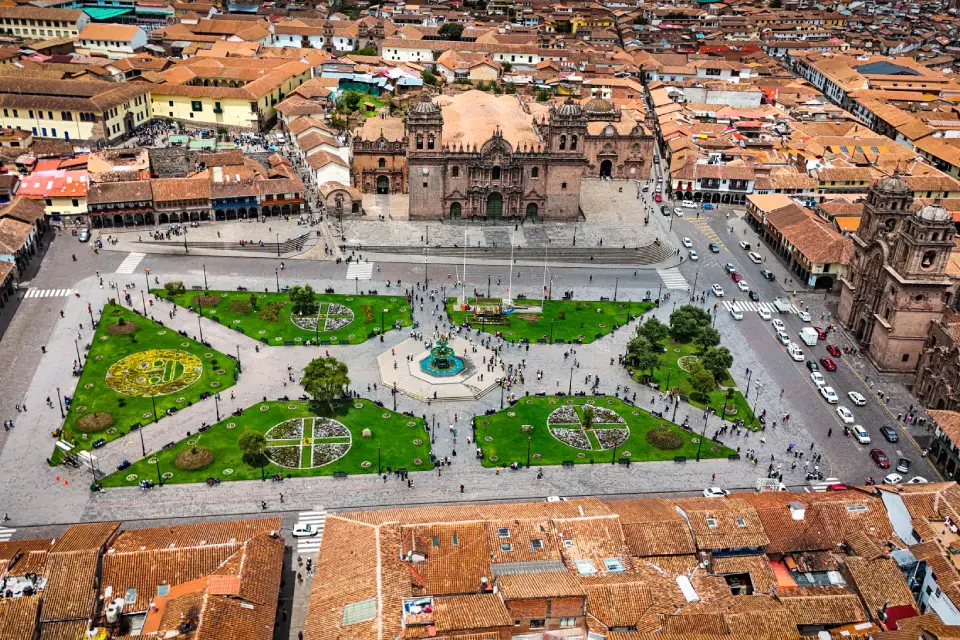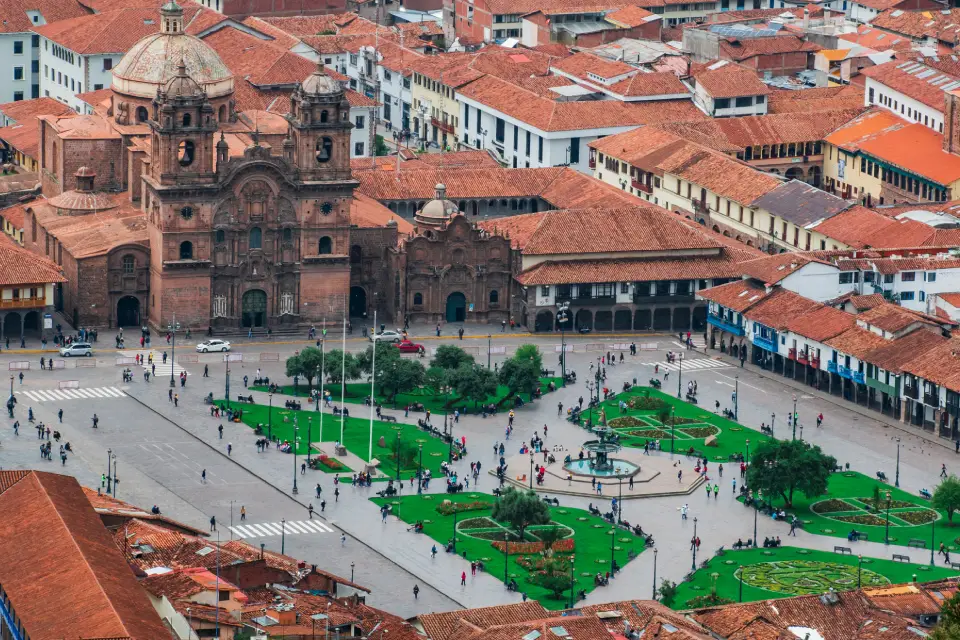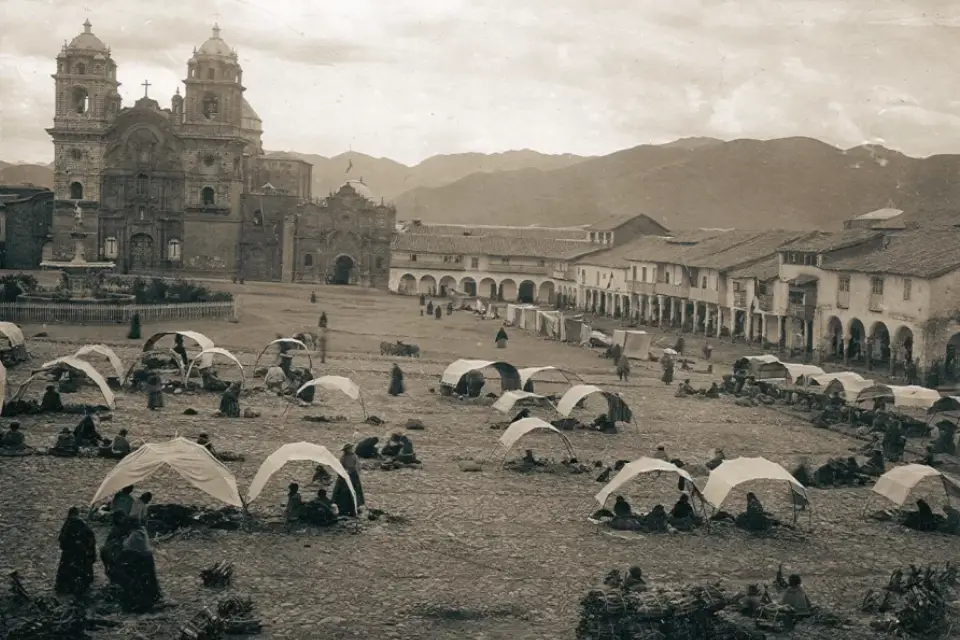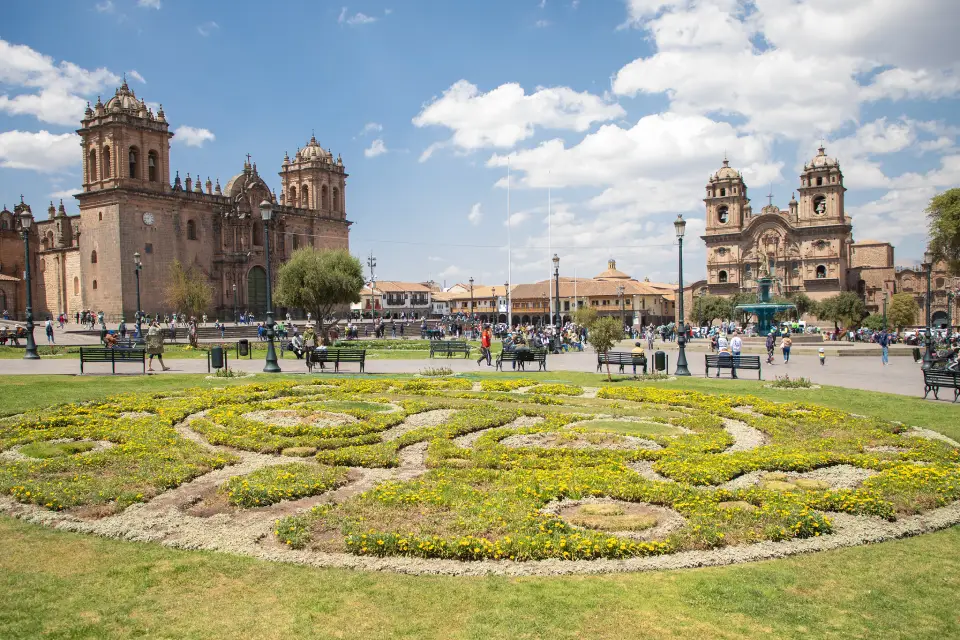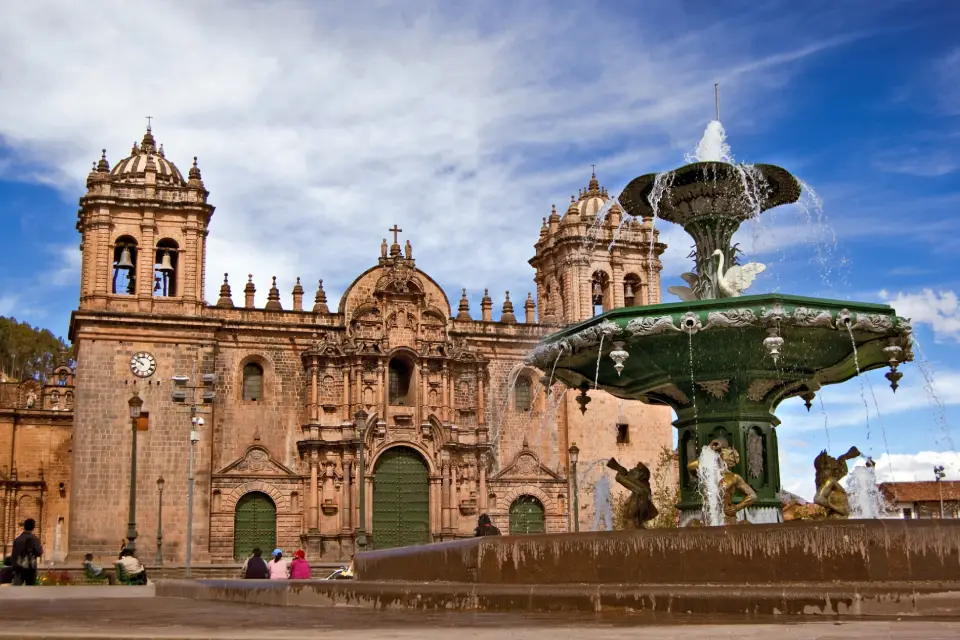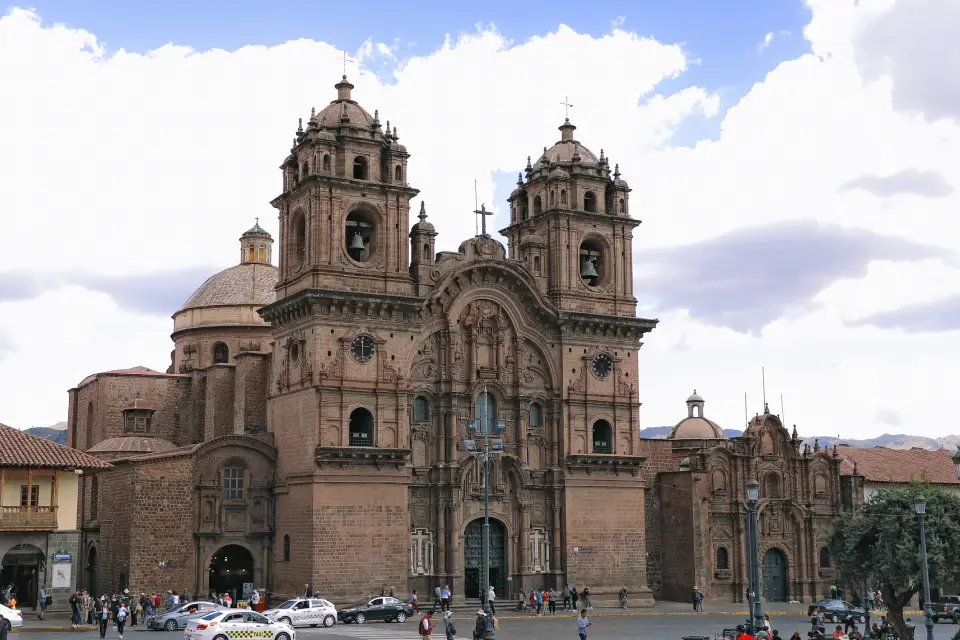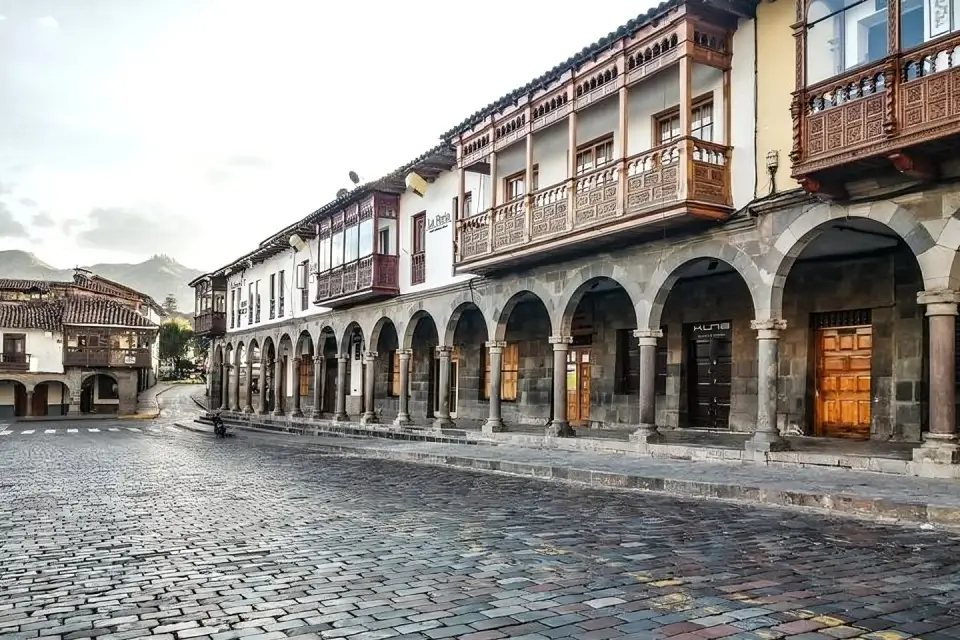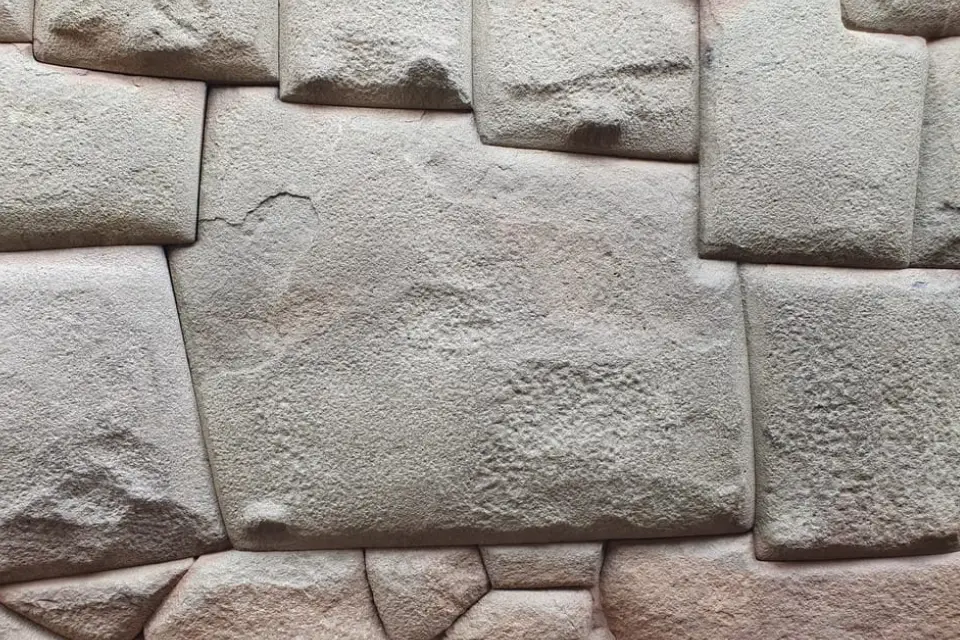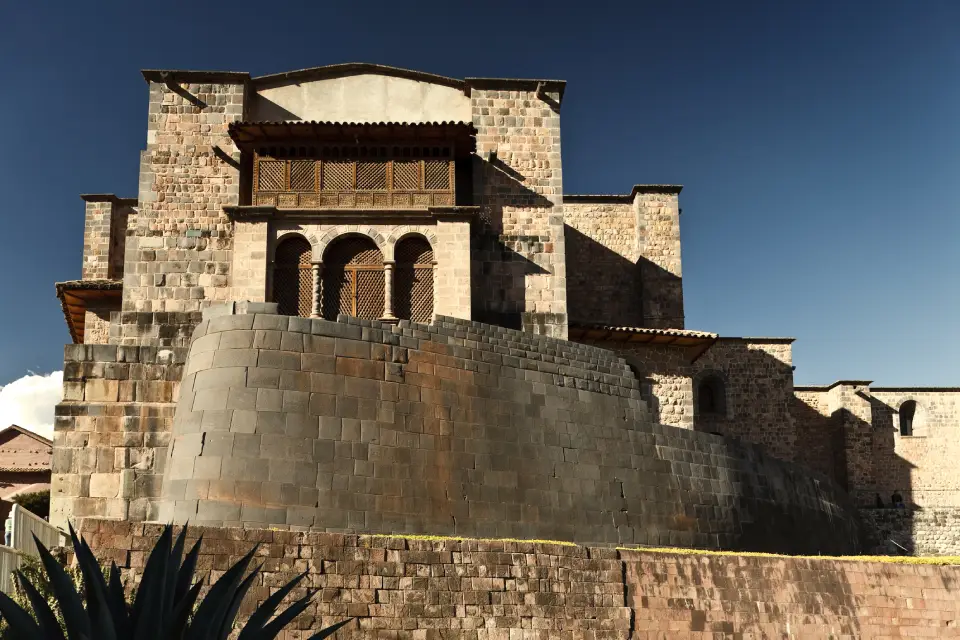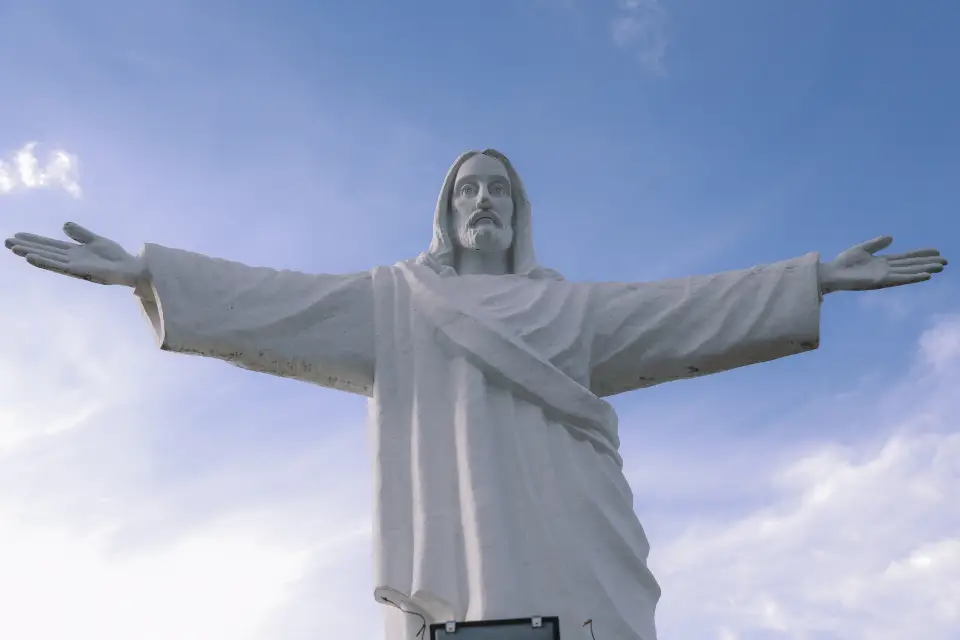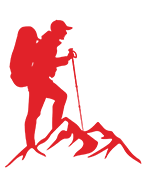Muchos visitan Perú por Machu Picchu, pero pocos saben que el verdadero corazón de esta ciudad es la Plaza de Armas del Cusco, conocido como el ombligo del mundo. Imagina un lugar emblemático donde se celebraban rituales al sol, se sellaban victorias y, más tarde, se erigieron majestuosas catedrales sobre cimientos incaicos. La Plaza de Armas no es solo una parada más; es la llave para entender la historia y el alma de Cusco.
Si estás planeando un viaje a Cusco, la Plaza de Armas debe estar en tu lista de imprescindibles. En este blog te enseñaremos todo sobre su historia, su cultura y sus tradiciones vivas que te transportarán en el tiempo. Explora este lugar lleno de vida y maravíllate con el alma del Cusco.
Plaza de Armas: Historia viva en el corazón del imperio inca
La Plaza de Armas de Cusco, ubicada en el centro histórico de la ciudad, es un espacio emblemático de interés histórico y cultural que refleja la fusión de las culturas inca y colonial. Rodeada de majestuosos edificios coloniales sobre cimientos incas como la Catedral y la Iglesia de la Compañía de Jesús. Este lugar fue el centro político, social y religioso del Imperio Inca, conocido como Huacaypata o Aucaypata, y más tarde transformado por los españoles. Hoy, la plaza es un importante punto turístico y escenario de festividades tradicionales como el Inti Raymi.
Ubicación
La Plaza de Armas está situada a 3,400 metros sobre el nivel del mar, en el centro histórico de la ciudad de Cusco. Sus coordenadas geográficas son 13.5150° de latitud sur y 71.9789° de longitud oeste. A su alrededor se encuentran imponentes edificaciones coloniales construidas sobre los antiguos cimientos incaicos como la Catedral del Cusco y la Iglesia de la Compañía de Jesús.
¿Cómo llegar a la Plaza de Armas de Cusco?
Para llegar a la Plaza de Armas es muy sencillo debido a su ubicación céntrica. Desde el aeropuerto internacional Alejandro Velasco Astete, puedes tomar un taxi o transporte privado que te llevará al centro histórico en aproximadamente 20 minutos. Si estás hospedado en el centro de Cusco, puedes llegar caminando, disfrutando de las pintorescas calles adoquinadas que rodean la plaza.
El nombre de la Plaza de Armas
Según varios estudios realizados existen varias hipótesis sobre el verdadero nombre en quechua de la Plaza de Armas del Cusco:
- María Rostorowski, la historiadora peruana asegura que este lugar se conocía como “Aucaypata”, que significa "lugar del guerrero".
- Por otro lado, el historiador cusqueño Víctor Angles propone que su nombre original era “Huacaypata”, que podría traducirse como "lugar del llanto".
- En cambio, el investigador norteamericano George Squier sostiene que el verdadero nombre habría sido “Huacapata”, cuyo significado es "lugar sagrado"
¿Por qué se llama Plaza de Armas?
El término "Plaza de Armas" se popularizó durante la época colonial, cuando los conquistadores españoles utilizaban las plazas principales o plazas mayores como puntos de concentración militar y defensa estratégica. En Cusco, este nombre perduró y se integró en la identidad del lugar.
Mejor época para visitar
La mejor época para visitar la Plaza de Armas de Cusco es entre los meses de mayo y octubre, cuando el clima es seco y las lluvias son mínimas. Durante este periodo, las mañanas son soleadas y las noches frescas, ideales para explorar la ciudad. Además, en junio se celebran importantes festividades como el Inti Raymi, donde la plaza se llena de color, música y tradición.
Historia oculta de Plaza de Armas de Cusco
Hace millones de años, la Plaza de Armas era un gran lago conocido como Morkill. Con el tiempo, el piso de esta plaza prehispánica fue rellenado con arena que se transportó desde la costa por orden de inca Pachacutec, el noveno gobernante inca. En aquel entonces, la elevación del piso estaba al menos un metro por debajo del nivel actual.
Periodo Pre inca
En el periodo pre inaca la Plaza de Armas de Cusco era una gran plaza rodeada de muchos palacios y santuarios de muchos asentamientos humanos como los Killque, quienes habitaron esta zona. Este lugar fue una zona pantanosa secada con el propósito de ser un espacio administrativo y religioso de la ciudad del Cusco.
Periodo de los Incas
Durante el Imperio Inca, el Huacaypata o Aucaypata fue el centro político, social y económico del Tahuantinsuyo. La plaza era amplia de unos 250 metros de largo por 120 metros de ancho y se dividía en dos áreas principales: Huacaypata, que representaba el llanto, y Cusipata, asociada al regocijo, lo que hoy se conoce como Plaza Regocijo.
En este periodo alrededor de la plaza se encontraban importantes edificios incas, como el Palacio de Huayna Cápac, el Palacio de Wiracocha, el Acllahuasi (la casa de las mujeres escogidas) y el Yachay Wasi (la casa del saber). En el centro de la plaza había un Ushno, una pirámide ceremonial trunca donde se realizaban rituales o ceremonias al dios sol.
Además, en esta plaza se celebraban grandes festividades como el Inti Raymi, en honor al sol, el Huarachicuy, la danza del Amaru y el Capac Raymi. También se realizaban las principales ferias de trueque y se celebraban las victorias del ejército inca, convirtiéndo se en un lugar clave de la vida cotidiana.
La conquista y el periodo Colonial
Con la llegada de los españoles, la plaza principal de Cusco sufrió grandes cambios significativos y fue transformada radicalmente. Los conquistadores construyeron estructuras coloniales sobre los cimientos incas, reemplazaron los edificios y palacios incas por iglesias y casonas coloniales. La iglesis de la Compania de Jesus reemplazó al palacio de Huayna Capac, el convento Santa Catalina reemplazó al Aclla Wasi, una casona colonial reemplazó al Suntur Wasi, la Catedral reemplaza al palacio de Wiracocha, un grupo de casas coloniales remplazaron al Yachay Wasi y finalmente la piramide trunca o Ushno fue remplazado por la Pileta de Agua.
El Cabildo del Cusco: La Transformación de la Plaza de Armas en 1542
En 1542, el cabildo del Cusco, liderado por Sebastián Garcilaso de la Vega (padre del cronista Inca Garcilaso de la Vega), mandó construir casonas en la gran plaza. Esto cubrió el riachuelo Saphy y dividió la plaza en tres partes: la Plaza de Armas, la Plaza Regocijo y la Plazoleta de la Merced. Las nuevas construcciones, como el Hotel del Cusco y los portales Comercio y Espinar, marcaron esta transformación.
En 1545, el corregidor Polo de Ondegardo ordenó retirar la arena del suelo de la plaza para usarla en la construcción de la Catedral del Cusco. Durante este periodo, destacaron la Catedral y la Iglesia de la Compañía de Jesús, que mezclan la arquitectura inca y colonial, reflejando la historia de la ciudad tras la conquista.
La Plaza de Armas del Cusco en la actualidad
Actualmente la Plaza de Armas del Cusco es el lugar más emblemático de la ciudad. Aquí se mezclan elementos del pasado y del presente: las construcciones coloniales se levantan sobre los sólidos cimientos de la arquitectura inca. Este espacio es un testimonio vivo de la convivencia entre la historia incaica, la herencia colonial y la vida moderna. Está rodeada de restaurantes, tiendas y eventos culturales que la llenan de vida y dinamismo.
Hoy en día la plaza es un espacio de interacción social y cultural, el punto de encuentro para los cusqueños y una parada obligatoria para los turistas. Además es el punto de partida para explorar los principales atractivos turísticos de Cusco. Finalmente es el centro de todas las festividades del Cusco que reúne a millones de turistas nacionales y extranjeros.
Acontecimientos importantes en Plaza de Armas del Cusco
- En 1536 Manco Inca se rebeló y empezó una guerra sangrienta contra los invasores españoles.
- En 1572 Tupac Amaru fue derrotado, capturado y ejecutado cortándole la cabeza en la Plaza Mayor o Plaza de Armas del Cusco.
- 1983 la Plaza de Armas del Cusco fue declarada Patrimonio de la Humanidad como parte de la ciudad de Cusco.
- En 2011 pusieron la estatua del inca Pachacutec en la Plaza de Armas del Cusco.
- En 2014 la plaza de Armas de Cusco fue declarada Patrimonio de la Humanidad como parte del Qhapaq Ñan.
Qué ver en la Plaza de Armas de Cusco
La Catedral del Cusco
La Catedral del Cusco, conocida como la Catedral Basílica de la Virgen de Asunción, es el principal templo y uno de los monumentos más importantes de la ciudada del Cusco, construida entre los años de 1560 y 1664 sobre los cimientos de dos estructuras incas el Quishuarcancha, antiguo palacio del inca Wiracocha y el Suntur Wasi.
Esta majestuosa edificación combina estilos arquitectónicos renacentista, barroco y gótico, siendo testimonio viviente del sincretismo cultural entre dos culturas, inca y española.
Iglesia de la Compañía de Jesús
La Compañía de Jesús del Cusco, también conocida como la Iglesia de la Compañía de Jesús, es uno de los edificios religiosos más emblemáticos de la ciudad de Cusco. Ubicada en la Plaza de Armas, esta iglesia es un claro ejemplo de la grandiosidad del arte barroco colonial en América Latina. Su importancia radica no solo en su arquitectura, sino también en su historia y papel cultural dentro de la región.
La pileta de agua y la estatua del inca Pachacútec
La pileta de agua fue donada por la ciudad de Nueva York y diseñada por el francés JP Víctor André en 1872. Se dice que New York y Cusco comparten la misma pileta porque ambos son el centro del universo. En el centro de la Plaza de Armas, sobre la pileta, se encuentra la estatua de Pachacútec. Esta figura representa al gran líder inca que logró expandir el Tahuantinsuyo y consolidar el poderío de su imperio.
Portales de la Plaza de Armas
Alrededor de la Plaza de Armas del Cusco existen ocho portales, cada uno con historias fascinantes y nombres curiosos que han cambiado a lo largo del tiempo. Estos portales forman parte de las casonas coloniales y se caracterizan también por presentar balcones.
- Portal de Carnes: Conocido también como el Portal de la Inquisición hasta 1985. Este portal era donde se vendían carnes.
- Portal de las Harinas: Denominada así porque los dueños de las casa aledañas vendían harina de trigo, maíz y haba.
- Portal de Panes: Antiguamente llamado portal de la bofetada, según la historias el español Benito Suarez de Carbajal le dio una bofetada al padre franciscano Orriamún por negar que una mujer compre pan.
- Portal de confitería: Anteriormente en este portal se venden frituras de vísceras de animales, llamado así por una señora vendía turrones y confites.
- Portal del Comercio: Posteriormente fue llamado portal ropavejero, cambio de nombre debido a los productos de ultramar que vendían los españoles y judíos, vendían la tela fina
- Portal de la Compañía: Antiguamente Portal de Sastres hasta la inauguración Jesuita.
- Portal de Carrizos: Por la venta de carrizos y madera maguey que se realizaban en este sitio, utilizado para la construcción de viviendas.
- Portal de Belén: Dedicado en honor a la virgen de Belén, por poseer el título de Patrona de Armas y de la ciudad del Cusco. Muchos devotos estuvieron de acuerdo con la decisión del Obispo Juan Alonso Bocón.
Calle Loreto
La calle Loreto, una de las más antiguas del Cusco, destaca por su herencia incaica y su ubicación junto a la Plaza de Armas. Fue parte de los caminos reales del imperio inca, y hoy fascina por sus imponentes muros de sillería, piedras perfectamente talladas y ensambladas sin mortero, que evidencian la destreza de la ingeniería inca. Además, sus edificios coloniales con balcones tradicionales complementan una fusión única entre las arquitecturas inca y española, creando un paisaje histórico que ha resistido con éxito el paso del tiempo.
La Piedra de los 12 Ángulos
La calle Hatunrumiyoc es famosa y destaca por la piedra de los 12 ángulos, una muestra única de la habilidad inca en el tallado de piedra. Esta calle, que fue parte de los caminos reales incas, está rodeada por murallas que han resistido el paso de los siglos.
La piedra de los 12 ángulos, hecha de diorita, impresiona por sus cortes precisos que encajan perfectamente, debido a que están construidos con tanta precisión, reflejando la habilidad y el conocimiento avanzado de los incas. Los incas usaron una técnica llamada mampostería de sillar, donde las piedras se cortaban y pulían para encajar sin mortero, esta técnica asegura la resistencia y estabilidad de las estructuras.
Plaza Regocijo
La Plaza Regocijo, también llamada Kusipata, se encuentra a pocos pasos de la Plaza de Armas. En la época inca, formó parte de la Plaza de Armas y fue un lugar importante para reuniones y celebraciones. Su nombre en quechua, que significa "lugar de felicidad," refleja su historia. Hoy, la plaza es un espacio tranquilo rodeado de edificios coloniales con arcos y balcones de madera, que combinan cimientos incas con arquitectura española. En el centro de la Plaza se encuentra una pequeña, rodeada de áreas verdes que la convierten en un sitio ideal para relajarse y disfrutar del ambiente histórico.
Los restaurantes y la vida nocturna
La Plaza de Armas ofrece opciones gastronómicas para todos los gustos, desde comida deliciosa hasta una vida nocturna vibrante. Aquí algunas recomendaciones:
Restaurantes Populares
- Cicciolina
- Papachos
- Limo
- Mistura Grill
- La Morena Morena Peruvian Kitchen
- Cholos Grill restaurant
- Greens Organic
Vida nocturna: Bares y discotecas
- Norton Rat's Pub
- El chango
- El IncaTeam
- Mama Africa
- El Duende Resto Lounge
Sitios cercanos a la Plaza de Armas de Cusco
Coricancha: El Templo al Sol
El Coricancha o templo al Sol más sagrado del Imperio Inca, se encuentra. Este lugar fue un centro religioso, político y astronómico del Imperio Inca, dedicado al dios Inti (el Sol). Su arquitectura combinaba impresionantes muros de piedra perfectamente ensamblados con una superposición arquitectónica, sobre sus bases inca se construyó el Convento de Santo Domingo, símbolo de fusión cultural y espiritual entre las tradiciones andinas y el cristianismo.
Barrio de San Blas
San Blas, en Cusco, conocido como el "barrio de los artesanos" es un barrio mágico con calles adoquinadas, arte y artesanías únicas. Sus galerías, talleres y la famosa Iglesia de San Blas, con su púlpito tallado en cedro, son imperdibles. El ambiente animado, los mercados y espectáculos lo hacen ideal para pasear, especialmente los fines de semana.
Mercado San Pedro
El Mercado de San Pedro, uno de los más antiguos y emblemáticos del Cusco cerca de la Plaza de Armas, es el lugar perfecto para vivir la cultura local. Aquí encontrarás frutas frescas, comidas típicas y artesanías hechas a mano. Visítalo temprano para disfrutar su energía única, lleva cambio pequeño, una bolsa reutilizable y anímate a probar algo nuevo.
Cristo Blanco
El Cristo Blanco es una gran estatua de Jesucristo de 8 metros de altura, ubicada en una colina con vistas espectaculares del Cusco. Fue un regalo de la comunidad palestina refugiada tras la Segunda Guerra Mundial, como símbolo de paz. Se puede llegar fácilmente en taxi o caminando desde el centro histórico de la ciudad.
Sacsayhuamán
Sacsayhuamán, una imponente fortaleza inca cerca de la Plaza de Armas de Cusco, sorprende con sus enormes piedras perfectamente encajadas y vistas espectaculares de la ciudad. Puedes llegar caminando, en taxi o en bus turístico, y lo ideal es visitarla temprano o al atardecer para evitar multitudes.
Recomendaciones para tu visita
- Usar ropa cómoda y adecuada para el clima cambiante de Cusco.
- Hidrátate constantemente y tómate el tiempo necesario para aclimatarse a la altura.
- Si planeas visitar durante las festividades, reserva alojamiento con anticipación.
- Usa protector solar, ya que la radiación solar en Cusco puede ser alta.
- Una cámara fotográfica o teléfono para capturar hermosas vistas.
Preguntas frecuentes
- ¿Qué es la Plaza de Armas del Cusco?
La Plaza de Armas de Cusco es el corazón de la ciudad, donde la herencia inca y la influencia colonial española se mezclan entre sus majestuosos edificios y tiendas llenas de vida, creando un espacio único que refleja el espíritu de su gente. Además, de ser un punto de encuentro para los locales y turistas.
- ¿Cuál es el estilo arquitectónico de la Plaza ?
El estilo arquitectónico que rodea a la Plaza de Armas es una mezcla de estilos inca y colonial español. Esta mezcla única refleja la historia rica de la ciudad y la fusión de dos culturas que dejaron una profunda huella en su arquitectura.
- ¿La Plaza de Armas está abierta las 24 horas?
Sí, es segura, pero como en cualquier lugar turístico, es importante mantener precauciones con tus pertenencias personales, especialmente en horas de mayor afluencia.
- ¿Es segura la Plaza de Armas para turistas?
Si, es muy segura la Plaza de Armas, pero como en cualquier lugar turístico, es importante mantener precauciones con tus pertenencias personales, especialmente en horas de mayor afluencia.
- ¿Cuánto tiempo se recomienda dedicar a la visita?
Depende de tus intereses, una visita promedio puede durar entre 1 y 2 horas, pero si decides explorar los alrededores o entrar a museos y catedrales, podrías necesitar más tiempo.
- ¿Puedo comprar souvenirs en la Plaza de Armas ?
Si, en la Plaza de Armas encontrarás numerosas tiendas y vendedores que ofrecen artesanías hechas a mano, textiles, joyas y ropa de lana de alpaca. Es un lugar ideal para adquirir recuerdos únicos y regalos que representan la rica cultura local.
- ¿Es necesario pagar entrada para acceder a la Plaza de Armas?
No, el acceso a la Plaza de Armas es completamente gratuito como en todas las plazas de las ciudades de Cusco y Peru. Puedes recorrerla y disfrutar de su ambiente sin ningún costo.
- ¿Es un lugar muy concurrido?
Si, hay mucha gente en la Plaza de Armas especialmente durante festivales y temporadas altas de turismo, suele estar llena de vida y actividad. Sin embargo si prefieres menos gente puedes visitarlo por la mañana o tardes.
- ¿Puedo encontrar guías que hablen inglés?
Sí, muchos operadores turísticos en Cusco tienen guías que hablan inglés. Estos guías cuentan historias y comparten datos interesantes sobre la Plaza de Armas y sus alrededores, haciendo que su visita sea más enriquecedora y única
- ¿Se puede acceder a la Plaza de Armas en transporte público?
Sí, la Plaza de Armas está bien conectada mediante transporte público. También es fácil llegar en taxi o a pie desde muchas partes de la ciudad.

